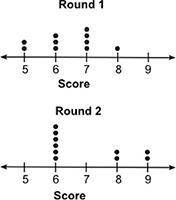
Mathematics, 21.05.2021 18:00 rileymorrison8825
PLZZZ HELPPP
The dot plots below show the scores for a group of students who took two rounds of a quiz:
Which of the following inferences can be made using the dot plot?
The range of each round is the same.
There is no overlap between the data.
Round 1 scores were higher than round 2 scores.
Round 2 scores were lower than round 1 scores.


Answers: 2


Another question on Mathematics

Mathematics, 21.06.2019 20:00
Need ! the total ticket sales for a high school basketball game were $2,260. the ticket price for students were $2.25 less than the adult ticket price. the number of adult tickets sold was 230, and the number of student tickets sold was 180. what was the price of an adult ticket?
Answers: 1

Mathematics, 21.06.2019 22:30
Which set of lengths could represent the sides of a triangle? a. 3, 7, 10 b. 4, 5, 10 c. 6, 8, 14 d. 12, 6, 7
Answers: 1

Mathematics, 22.06.2019 00:00
50 will mark show all use the linear combination method to solve the system of equations. explain each step of your solution. if steps are not explained, you will not receive credit for that step. 2x+9y= -26 -3x-7y=13
Answers: 1

Mathematics, 22.06.2019 03:00
In this problem, we explore the effect on the standard deviation of multiplying each data value in a data set by the same constant. consider the data set 14, 6, 8, 15, 15. (a) use the defining formula, the computation formula, or a calculator to compute s. (round your answer to one decimal place.) s = 4.28 (b) multiply each data value by 3 to obtain the new data set 42, 18, 24, 45, 45. compute s. (round your answer to one decimal place.) s = 12.83 (c) compare the results of parts (a) and (b). in general, how does the standard deviation change if each data value is multiplied by a constant c? multiplying each data value by the same constant c results in the standard deviation remaining the same. multiplying each data value by the same constant c results in the standard deviation being |c| times as large. multiplying each data value by the same constant c results in the standard deviation increasing by c units. multiplying each data value by the same constant c results in the standard deviation being |c| times smaller. (d) you recorded the weekly distances you bicycled in miles and computed the standard deviation to be s = 3.8 miles. your friend wants to know the standard deviation in kilometers. do you need to redo all the calculations? yes no given 1 mile ≠1.6 kilometers, what is the standard deviation in kilometers? (enter your answer to two decimal places.)
Answers: 1
You know the right answer?
PLZZZ HELPPP
The dot plots below show the scores for a group of students who took two rounds of a q...
Questions

Mathematics, 14.04.2020 21:29




History, 14.04.2020 21:29




History, 14.04.2020 21:29











Mathematics, 14.04.2020 21:30




